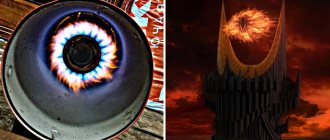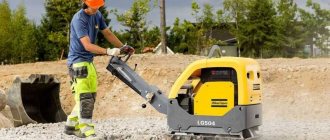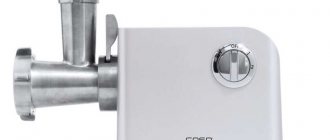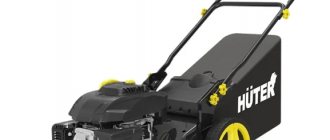Despite all their advantages, conventional oil heaters and convectors are simply not able to quickly warm the air to the required temperature in large rooms. Heat guns cope well with this task. Today there are a wide variety of models on the market. They are widely used for heating warehouses, industrial premises, greenhouses and other large areas. They are also indispensable on open construction sites for creating and maintaining a comfortable temperature in the work area.
Heat gun: what is this unit?
This is a powerful device that allows you to warm the air in a room to a given temperature in a matter of minutes, distributing it evenly over the entire area. This device is very popular today, because it can be installed in almost any room and outdoor area. It can serve as a source of heating areas during the cold season in the absence of other types of heating.
Heat gun device
The principle of operation of a heat gun is to generate a hot stream of air, which, with the help of a powerful fan, is driven towards the heating element. Passing through it, the air warms up, and then the heat flow is evenly distributed throughout the room. Most models of these devices look like a pipe, which is how this device got its name.
Heat guns are equipped with a durable metal casing designed to protect them from any damage, and the heating element is completely fireproof. Almost all of them are mobile and do not weigh too much, which allows you to effortlessly move the device to another place.
What to choose?
Based on the above-described design features of gas heaters, we can advise our readers the following:
- If you need a stationary heater that can be used both constantly and from time to time, choose a gas convector.
- If you need to heat a couple of rooms with a total area of up to 20 square meters, then buy a catalytic heater - it is safe and silent.
- If you want to heat your entire dacha, garage, shed or warehouse, buy an infrared heater with a ceramic burner.
- If you need to heat a pavilion, open area or gazebo, buy a heat gun.
Types of heat guns
All existing heat guns can be divided into several groups depending on the fuel consumed or electricity used. The most common types of these devices are:
- diesel;
- gas;
- electric.
Types of heat guns
In turn, those operating on liquid fuel, and in particular diesel ones, can be either directly heated or indirectly, when combustion products are removed from the room. To operate gas heat guns, both main gas and cylinders can be used. Most often, these 2 types of devices are used to heat the premises of buildings under construction or where there is no access to electrical networks. When these devices operate, oxygen is burned, as a result of which their use is more relevant outdoors or indoors where there is supply ventilation.
Heat guns powered by electricity are practically free of such disadvantages as burning oxygen while heating the air. Therefore, they are more often used in residential, retail, office or other similar premises.
Gas converter: stationary home heating
A stationary converter is a somewhat unusual heating device. After all, its combustion chamber is located, as it were, outside the house, although it is physically located right in the apartment. Moreover, the chamber itself is isolated from the living space - the air necessary to maintain combustion is taken directly “from the street”, through a special pipe, and combustion products are also discharged there. And the gas itself is not heated by the usual “circuit” with the coolant, but by the cast-iron or steel body of the combustion chamber, blown by “apartment” air.
Gas converter
Therefore, such heating devices are truly a real alternative to a gas boiler. After all, the boiler heats the coolant that feeds the radiators. As a result, the boiler must be heated constantly, even in the case of temporary residence in the country. Otherwise, under the pressure of frozen water, the tubes, batteries, and the boiler itself will burst. In turn, the gas converter can be “heated” only when the dacha owners need it. After all, there is no coolant in the converter that is prone to freezing.
Moreover, the converter itself is easy to install: a through, horizontal groove is punched into the wall, from the side of the room, into which the converter pipe is inserted, then a bracket is hung on the wall to take the weight of the converter, and the end of the pipe is inserted into a special pipe on its body. After this, all that remains is to seal the gap between the walls of the groove and the pipe and introduce into the room, through a separate channel, a branch from the gas pipeline, removed from the external “piping” of the home. There is no need to build chimneys, hoods, etc.
In addition, a stationary converter is a very productive device. It can heat up to 25-30 square meters of home. However, this wastes quite a significant amount of gas. Therefore, converters are connected either to a central line or to an autonomous storage facility with a capacity of up to 5-6 standard gas cylinders.
As a result, despite the positive and, in some cases, enthusiastic reviews of gas heaters for dachas built according to this scheme, the use of stationary converters in dacha heating systems is still not recommended. They are very “gluttonous”.
Which heating gun is better to choose?
When choosing a heat gun to heat a certain room, as when purchasing any other equipment, you should always correlate your needs with the available capabilities. First of all, you need to decide what exactly this device is needed for - for permanent or temporary use, for regular heating of the room or for using the device only for periods.
Heat gun design
In addition to these factors, you will need to consider:
- the size of the room in which the air will need to be heated;
- availability of a particular energy source;
- the presence of ventilation in the room and the possibility of removing combustion products from it;
- permanent or temporary presence of people.
Advice. When choosing the required power of a heat gun, you can base your calculations on approximately the following: 0.8-1.4 kW per 10 sq.m.
To make it easier to understand the most suitable type of device, it is worth taking a closer look at each of the 3 types of guns, assessing the pros and cons of electric, diesel and gas equipment.
No. 7. Thermal power and its calculation
How to compare several different devices in terms of performance? How do you understand that one device is designed to heat small garages, while another can easily warm up a huge warehouse? You need to look at the power indicator, and we are not talking about the electrical power consumed, or rather not always about it. This parameter will be indicative only for electric models. So let's start with them.
The power of electric guns ranges from 1 to 50 kW. It’s difficult to call 1-3 kW models “guns” - they’re more like fan heaters. Let us repeat that devices with a power of up to 5 kW can be connected to a 220 V network. Anything larger is equipment that requires a 380 V network. The most powerful electric guns are devices up to 100 kW.
The power of gas appliances ranges from 10 to 150 kW, but more powerful devices are often found. Diesel and multi-fuel direct heating devices produce all 220 kW, but their indirect heating counterparts have less power - a maximum of 100 kW. Infrared guns are rarely more powerful than 50 kW.
How do you know how much power is needed? Many people advise using an approximate calculation method, according to which 1-1.3 kW of power is sufficient for 1 m2 of space. If the room is low and well insulated, you can multiply by 1 kW, and if there are problems with thermal insulation, then it is better to take the coefficient with a margin.
If you want to get a more accurate result, then arm yourself with a calculator and the following calculation procedure:
- calculate the volume of the room , since this parameter is much more important than the area parameter. If you take a room with an area of 90 m2 and imagine that the ceiling height in it is 4 m, then the volume will be 360 m3;
- temperature difference between the desired indicator indoors (for example, +180C) and the indicator outside the walls. The weather outside in winter can be different. It is usually recommended to take into account the average winter temperature, making allowances for possible frosts. If the gun is the main source of heat, then it is better to take into account the lowest winter temperature. If you are making calculations for a residential building, then choose the comfortable internal temperature yourself. For warehouses, the accepted temperature is +120C, for public buildings - +180C. So, let’s say that in winter there are often frosts down to -200C outside, but inside you need to maintain the temperature at +180C, then the difference will be 380C;
- thermal insulation of the room plays an important role. A special coefficient is taken into account when calculating the power of the gun. If all walls, floor and roof are insulated, the number of windows is small, they have double frames, then k = 0.6-1. If the walls are brick, but without insulation, the roof is standard, and the number of windows is average, then k = 1-2. For structures with a single brick wall and single window frames (garages, for example), the coefficient k = 2-3 is used. For open and semi-open areas, simplified wooden and metal structures without thermal insulation, k = 3-4. Let's say we have a garage with double brick walls without thermal insulation, into which visitors will more or less often enter, then we will assume that k = 1.8;
- Thermal power is calculated using the formula Q = k*V*T. Then we get Q = 1.8*360*38 = 24,624 kcal/h, and since there are 860 kcal/h in 1 kW, it turns out that Q = 24624/860 = 28.6 kW;
- if the gun is not the only source of heat in the room, then this must be taken into account and the power of the existing equipment must be subtracted from the final result;
- You can take more than one high-power gun, but several smaller ones, in order to ultimately obtain the necessary power. If the room has a complex configuration, then several less powerful guns are even better than one more powerful one.
Diesel fuel heat guns
The design of diesel units is quite simple. These devices consist of:
- fan;
- burners;
- combustion chambers;
- fuel tank.
Diesel fuel heat gun
These are the main parts of the device; many models are equipped with wheels for moving the device. Fuel is supplied using a compressor or pump. Heat flow is created when an electric fan operates. They can work autonomously, for which the devices contain a thermostat, timer, and flame control system. They come in different capacities. No permission is required to install them.
In devices with a direct heating type, all combustion products are discharged immediately into the surrounding air. Because of this, they are not suitable for heating rooms where people live. Units with indirect heating are less powerful, but much safer to operate. They have a special tube, with the help of which combustion products are removed from the room by connecting to the chimney. Such devices can already sometimes be used in rooms where people are located, if there is ventilation or regular ventilation there. But due to the high noise level during operation of the device, its use in residential, commercial or office areas is not very frequent.
Direct heating diesel fuel heat gun
The main purpose of diesel units is to heat rooms such as:
- production workshops;
- industrial areas;
- construction projects;
- warehouses;
- open areas;
- premises for agricultural purposes.
In addition, diesel guns are often used for drying and defrosting various materials, as well as to speed up the drying process of treated indoor surfaces during repair work.
Advantages and disadvantages of devices
When choosing an emergency room heating unit, you need to weigh all the advantages and disadvantages of the device in each specific case. Considering the operating conditions, both a gas and a diesel appliance may be the best option. Several factors may influence the choice:
- ease of operation;
- saving heat source consumption;
- cost of combustible material;
- dimensions and transportation conditions;
- application area;
- heating area;
- safety;
- reliability.
Each heat gun option has its own distinctive advantages. The main thing is that they coincide with the priorities in the operation of the device. A gas unit is cheaper in cost, but it is necessary to replenish liquefied gas supplies somewhere if there is no connection to the central gas main. Diesel fuel is easier to purchase and store, but such devices are quite heavy, which limits their mobility. If there is no need to constantly move the heat gun from place to place, but use it as a stationary heating element, then you can ignore this parameter.
If we consider the efficiency of heating, then if irregular operation is necessary, gas guns are better suited. They heat the room much faster and are easily transported. Due to the fact that there are no combustion products, the devices can be freely used in residential areas. Diesel devices, on the contrary, are dangerous to human health due to the accumulation of waste from the device’s operation in the air.
To determine the optimal type of heat gun, compare the technical capabilities of the device with individual needs, as well as the economic feasibility of using such heating devices.
Gas heat guns
Heat guns using gas can be called the most economical and productive. Like diesel engines, they are most often used in non-residential premises: construction sites, pavilions, workshops, production facilities, greenhouses. But they are also used for heating residential premises if they have forced ventilation, as well as for drying surfaces after finishing work during repairs.
Attention! Gas-powered guns are not used to heat basements or rooms where animals are kept.
Propane or butane is used as fuel in such units. They can be connected to the main gas pipeline, which significantly reduces the cost of heating the room, or run from liquefied gas cylinders. Many models of these devices, when replacing some parts, can be connected in one way or another, depending on access to the line in each specific case. When a gas heat gun operates, no smoke or odor is emitted. Models of varying power are produced, many of which are capable of effectively heating fairly large areas. All of them are quite simple both in maintenance and transportation.
Gas heat gun
The distinctive features of these guns compared to other types include:
- fairly high performance;
- almost complete combustion of fuel;
- the distribution of heat flow throughout the room is most uniform;
- the electricity consumption required to operate the fan is minimal;
- mandatory presence of a thermostat;
- Possibility of use in crowded places.
Catalytic heaters
This type of heater has low power and is suitable for efficient heating of small rooms.
They can run on gas, gasoline or electricity. This heater is the safest, since no flame is emitted during operation; The liquefied gas collides with a fiberglass catalyst plate, converting the energy of the gas into heat. For the same reason, a catalytic gas heater is also environmentally friendly since it does not produce combustion products harmful to the environment and health. Some models are equipped with a fan that accelerates the spread of heat throughout the room. See also:
Which floor-standing air conditioner is better to choose for your home?
Heat guns powered by electricity
Units powered by electricity can serve as a source of both additional heating of areas and the main one. During their operation, oxygen is practically not burned, as a result of which they are often used in enclosed spaces, including offices and residential ones - in apartments and country houses.
Electric heat gun
They are compact in size, not too heavy, and are quite easy to carry from one place to another. Their power range is high and can be used to heat rooms of various sizes, even quite large areas. But if you compare them with gas or diesel counterparts, they are significantly less powerful, but they are easy to use and do not require fuel. To warm up the room to a comfortable temperature within just a few minutes, you just need to plug the unit into an electrical outlet.
The advantages of electric heat guns are:
- safety, reliability and durability;
- compactness, since there is no fuel tank and combustion chamber;
- mobility in moving the device;
- noiselessness during operation;
- no need for fuel;
- possibility of operation from the network or generator;
- no additional maintenance.
Advice. Despite the fact that the electric gun burns almost no oxygen in the room, it is still desirable to have ventilation in it. If there is no supply ventilation, it is necessary to regularly ventilate the room.
Among some of the disadvantages of these devices, only 2 can be identified:
- constant access to electrical networks for operation of the device;
- the cost of electricity is quite high, which leads to a significant increase in the cost of heating the room.
Electric heat guns are the lightest and safest.
When choosing a heat gun suitable for heating a particular room, you will need to evaluate various factors. All of them are quite important, so you need to carefully consider them before purchasing the device. The correct choice of device will help to effectively warm the air in the room in the shortest possible time and at a reasonable cost, making it comfortable for being there.
Types of gas heaters
All types of gas heating devices for garages are divided into two types of models:
- wall;
- mobile floor.
The first option is usually carried out in the form of a powerful convector for main gas, more precisely a mixture of gases produced and transported through a gas pipeline, in which methane predominates. He needs to supply a pipe with fuel and make a smoke exhaust.
Such devices are installed very rarely in garages. A compact mobile analogue, designed to operate from a cylinder, is cheaper, easier to install and does not require approvals for connection.
A private garage usually has a small area, so small-sized and cheap propane appliances are most often chosen to heat it.
According to the design and principle of operation, gas heaters are infrared and convection. To stimulate the movement of heated air, convection models may or may not be equipped with a fan. Each of these types has its own advantages.
Option #1 – infrared
The operation of IR heating devices is based on the principle of “thermal radiation” of electromagnetic waves with a length in the region of 9.2 microns. Such infrared rays calmly pass through the air in the room without delay and heat the surfaces opposite the heater. And from the walls, ceiling and various objects, heat spreads further throughout the room.
Radiation from a gas IR heater in a garage is absolutely safe for humans; even with prolonged exposure, it is not capable of causing damage to a car.
The source of radiation in an infrared gas device can be a direct open flame or a ceramic heating element that receives energy from the burned fuel. Next, the IR rays are directed in the desired direction using a reflector.
Infrared gas equipment for space heating:
- does not require electricity to operate;
- differs in compact sizes;
- economical;
- silently;
- does not create convection and does not raise dust.
The basic disadvantage of IR gas heaters for arranging a garage or cottage is a narrow beam of heat. After switching on, the infrared emitter heats only those surfaces in the treated space where it is directed.
At the same time, walls and objects outside the range of the device remain cold without direct heating. As a result, a situation is possible where one corner of the room is heated and comfortable for car repairs, while cold is coming from the other.
Gas IR heaters are found in stores in the form of heating pyramids. You shouldn’t take such models for a garage; they are designed for heating open spaces and spacious rooms
For small garages, propane-powered infrared devices in the form of ceramic stoves with a cylinder inside or compact emitter panels are most suitable. Both options usually have an oxygen and gas leak sensor, as well as fire protection. The power of such equipment is designed for heating garages ranging from 4 to 40 square meters. m.
Option #2 - catalytic
In catalytic infrared gas heaters, heat is generated due to the effect of catalysis - the oxidation of gas on a heating surface coated with platinum. There is no open flame as such. But as a result, propane “burns out” much more completely than in the case of a classic burner.
In terms of efficiency and power, catalytic and infrared gas heaters for garages are similar, but in terms of safety and environmental friendliness, the former are much superior to the latter
During operation, the heating element of the catalytic device heats up to 200 0C. At the exit, ordinary CO2 and H2O are formed, but oxygen is consumed several times less than during open combustion of gas fuel. Plus, as a result, propane burns out almost completely and without the formation of carbon monoxide CO.
Catalytic infrared heater:
- economical in fuel consumption;
- does not form carbon monoxide when heating;
- fireproof;
- favorable for breathing, oxygen burns in the garage to a minimum.
The main disadvantage of such a device is its short service life. The catalyst in it is designed for continuous operation in the region of 2–2.5 thousand hours. This is about five to six months, and after that the heater can be thrown away. It will be enough for one winter season, but no more.
Option #3 – convectors
Convector gas heaters for garages have a ceramic or steel heat exchanger inside, which is heated by an open flame and then transfers heat to the garage using natural air convection. Such a device has holes at the bottom for the intake of cold air, and at the top for the exit of hot air.
Convectors take a long time to warm up the garage space, but then effectively and with a minimum of fuel waste maintain the set temperature
Among the advantages of gas convectors:
- burning gas in a closed chamber;
- no combustion products escaping into the room;
- high efficiency in fuel consumption.
Installation of a gas convector is usually carried out on a wall in which a hole is punched for a coaxial chimney. For short-term heating of the garage, this option is ineffective. But if you need to maintain the temperature inside for a long time at 5–10 0C, then this is the most suitable choice.
Some convector-type models are equipped with an additional fan for forced air flow through the heat exchanger. Such heaters are characterized by increased performance and are capable of heating large areas. However, they require power supply to operate, whereas a conventional device does not depend on the presence/absence of power supply.
Option #4 – heat guns
The fastest of all gas heaters in terms of speed of warming up a garage are heat guns. They may have a fan inside or operate only due to the draft from the burned gas. The former are more powerful, but the latter do not require connection to the mains.
The combustion chamber in a heat gun can be open or closed. In the first case, all gas combustion products, albeit small in volume, are blown into the garage
A heat gun allows you to quickly heat the cubic capacity of air entrusted to it in order to create comfortable conditions for car repairs. But if the garage is not insulated, then the heat, just as quickly entering the room, will immediately leave it outside when such a heater is turned off.
Among the disadvantages of the “gun” is also the raised garage dust. During operation, the device creates a powerful stream of heated air, lifting even small debris from the floor and shelving in the garage. Otherwise, it is an efficient and powerful heating equipment.
Heat guns: photo
What kind of gas cylinder will you need?
This issue is also related to safety and ease of use. Previously, only metal cylinders were made, but now polymer-composite ones have begun to be produced. Their advantages:
- strength;
- light weight;
- gas quantity indicator (will not run out at the facility);
- check valve with a fusible element (in case of fire, it gradually releases fuel, preventing it from exploding).
It is recommended to use composite polymer cylinders; they are not subject to corrosion and are explosion-proof.










